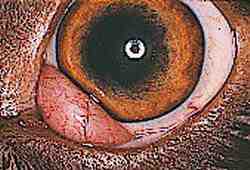article from PetTribue - http://www.pettribune.com/2001/090101/2020.html
 The
canine eye has two major tear glands that provide lubrication and nutritional
factors essential for the health of the eye. Tears moisten the mucous membranes
surrounding the eyeball (conjunctiva) and keep the clear surface of the
eye (cornea) glossy and transparent.
The
canine eye has two major tear glands that provide lubrication and nutritional
factors essential for the health of the eye. Tears moisten the mucous membranes
surrounding the eyeball (conjunctiva) and keep the clear surface of the
eye (cornea) glossy and transparent.
One tear gland is in the eye socket near the eyeball and the other gland lies behind the third eyelid. The gland associated with the third eyelid may spontaneously flip forward and protrude from between the two eyelids in the corner of the eye closest to the nose. Prolapse of the third eyelid gland, or cherry eye, is thought to occur in animals with a loose attachment of the base of the gland to the base of the third eyelid. This condition often occurs spontaneously without a known cause and may be precipitated by trauma or recent vaccination.
Breeds predisposed to this condition include the English bulldog, the American cocker spaniel, the beagle, the bloodhound, the Shar Pei, the Lhasa Apso, and the Newfoundland dog. In some animals, a second condition is present where the third eyelid stabilizing cartilage is kinked, contributing to prolapse of the third eyelid gland. Most animals with cherry eye are less than two years old. The protruding gland may sometimes be confused with a tumor or cyst.
Treatment of Cherry Eye
in the Dog
Treatment of cherry eye
focuses on replacing the gland to its normal position permanently. In some
cases, simply applying a local anesthetic and manually replacing the gland
will be effective. However, this is usually a temporary solution as the
gland will flip back out after several hours or days.
The gland can be replaced surgically under general anesthesia with either a pocket technique or an anchoring technique. The pocket technique buries the gland behind the third eyelid in a pocket created in the mucous membrane. The anchoring technique relies on a stitch that passes through the gland and secures it deep behind the third eyelid. It is the surgeon's preference as to which technique to use. Both techniques have a success rate of 85 percent to 95 percent, with complications including stitch knots rubbing on the eye and recurrence of the gland flipping forward.
Topical medications are required for several days following surgery as well as a protective Elizabethan collar (satellite dish) to prevent the animal rubbing at the eye and removing the stitches. The stitches are absorbable and dissolve after several weeks.
Consequences of Cherry
Eye
The prognosis for vision
and health of the eye is good if surgery to replace the gland is performed
in a timely manner. Cherry eyes left untreated may cause a yellow-green
discharge from the eye, redness, and the condition known as dry eye. Dry
eye is due to an abnormally low tear level and can cause corneal ulcers
and scarring that may render the eye painful and blind. Many of the breeds
prone to cherry eye are also prone to dry eye, making it all the more important
to identify and correct the problem.
Studies show that cherry eyes left untreated develop dry eye at a much higher rate than those eyes which are surgically repaired. Furthermore, in those eyes where the gland is simply snipped off and removed, the rate of dry eye is highest. Although cherry eye is not an emergency, prompt treatment of this problem will prevent serious complications for your pet in the future.
-Dr. Michelle Stengard is
a Diplomate of the American College of Veterinary Ophthalmologists. She
practices at Animal Eye Specialty Clinic, 3421 Forest Hill Blvd. West Palm
Beach, Fl. 33406, tel: (561) 967-5966.